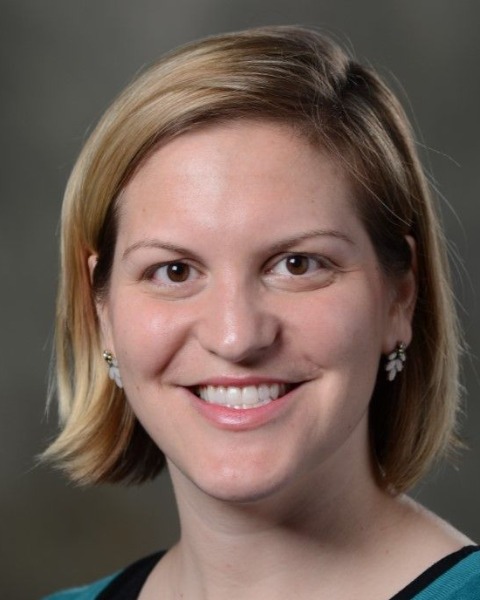Back
Pulmonology
Category: Abstract Submission
Pulmonology I
540 - Polysomnography and Pulmonary Function in Children and Teens with Severe Obesity
Saturday, April 23, 2022
3:30 PM – 6:00 PM US MT
Poster Number: 540
Publication Number: 540.242
Publication Number: 540.242
Benjamin H. Crain, NemoursAlfred I. duPont Hospital for Children, Wilmington, DE, United States; Linhda Nguyen, NemoursAlfred I. duPont Hospital for Children, Springfield, PA, United States; Abigail R. Strang, Nemours Children's Hospital, Garnet Valley, PA, United States; Aaron Chidekel, Nemours Alfred I. duPont Hospital for Children, Wilmington, DE, United States

Abigail R. Strang, MD (she/her/hers)
Pediatric Pulmonologist
Sidney Kimmel Medical College at Thomas Jefferson University
Garnet Valley, Pennsylvania, United States
Presenting Author(s)
Background: Obesity is increasingly prevalent in children in the US and is an important risk factor for respiratory disease. Children with obesity have a higher incidence of sleep-disordered breathing and impaired lung function. There are less published data on children with severe obesity (Class II and III, BMI ≥35 kg/m2).
Objective: The objective of this study is to describe polysomnogram (PSG) and pulmonary function testing (PFT) results from a cohort of children with severe obesity.
Design/Methods: This IRB-approved retrospective review consists of pediatric patients (ages 8–18 years) with BMI ≥ 35 kg/m2 studied at Nemours Children’s Hospital, Delaware from 2014-2021 who completed both PSG and PFT during the same 23-hour admission. Demographic, PSG, and PFT data were collected; descriptive statistics of the cohort were calculated.
Results: 257 children and adolescents were included in the analysis (mean age 15.2[+/-1.7] yrs, 64% female, 41% Caucasian, 47% African-American), and mean BMI of 50.2(+/-7.3) kg/m2. 67.5% of patients met criteria for obstructive sleep apnea (OSA) with apnea-hypopnea index (AHI) >5, and 16.7% of patients met criteria for severe OSA with AHI >30. On PSG, mean AHI is 18.9(+/-26.0) events/hr; mean obstructive apnea index (OAI) is 2.5(+/-7.9) events/hr; mean SpO2 nadir is 87.4(+/-7.8) %; mean awake baseline EtCO2 is 41.8(+/-2.7) mmHg; peak EtCO2 is 50.9(+/-4.2) mmHg. 9.2% of patients met criteria for hypoventilation with >25% time with EtCO2 >50 mmHg. On spirometry, mean forced vital capacity (FVC) is 103.1(+/-15.5) % predicted, forced expiratory volume (FEV1) is 96.2(+/-16.0) % predicted, mean absolute FEV1/FVC is 82(+/-7.4), and mean FEF25-75 is 86.4(+/-25.9)% predicted. 12.4% of patients showed bronchial reactivity with post-bronchodilator increase in FEV1>12%. On lung volume measurements by body plethysmography, mean total lung capacity (TLC) is 102.2(+/-16.5) % predicted, residual volume (RV) is 83.1(+/-39.8) % predicted, expiratory reserve volume (ERV) is 70.1(+/-25.6)% predicted. Mean diffusion capacity (DLCO) corrected for alveolar volume is 97.1(+/-21.5) %.Conclusion(s): PSG and PFT abnormalities are prevalent in this cohort of youth with severe obesity. OSA was diagnosed in the majority of the patients, although gas exchange abnormalities were less common. While spirometry was often normal, static lung volume measurements were not, suggesting that lung volume measurements by plethysmography are necessary to first detect impaired lung function. Clinicians who care for children with severe obesity should consider PSG and PFT testing to evaluate for respiratory compromise.
Objective: The objective of this study is to describe polysomnogram (PSG) and pulmonary function testing (PFT) results from a cohort of children with severe obesity.
Design/Methods: This IRB-approved retrospective review consists of pediatric patients (ages 8–18 years) with BMI ≥ 35 kg/m2 studied at Nemours Children’s Hospital, Delaware from 2014-2021 who completed both PSG and PFT during the same 23-hour admission. Demographic, PSG, and PFT data were collected; descriptive statistics of the cohort were calculated.
Results: 257 children and adolescents were included in the analysis (mean age 15.2[+/-1.7] yrs, 64% female, 41% Caucasian, 47% African-American), and mean BMI of 50.2(+/-7.3) kg/m2. 67.5% of patients met criteria for obstructive sleep apnea (OSA) with apnea-hypopnea index (AHI) >5, and 16.7% of patients met criteria for severe OSA with AHI >30. On PSG, mean AHI is 18.9(+/-26.0) events/hr; mean obstructive apnea index (OAI) is 2.5(+/-7.9) events/hr; mean SpO2 nadir is 87.4(+/-7.8) %; mean awake baseline EtCO2 is 41.8(+/-2.7) mmHg; peak EtCO2 is 50.9(+/-4.2) mmHg. 9.2% of patients met criteria for hypoventilation with >25% time with EtCO2 >50 mmHg. On spirometry, mean forced vital capacity (FVC) is 103.1(+/-15.5) % predicted, forced expiratory volume (FEV1) is 96.2(+/-16.0) % predicted, mean absolute FEV1/FVC is 82(+/-7.4), and mean FEF25-75 is 86.4(+/-25.9)% predicted. 12.4% of patients showed bronchial reactivity with post-bronchodilator increase in FEV1>12%. On lung volume measurements by body plethysmography, mean total lung capacity (TLC) is 102.2(+/-16.5) % predicted, residual volume (RV) is 83.1(+/-39.8) % predicted, expiratory reserve volume (ERV) is 70.1(+/-25.6)% predicted. Mean diffusion capacity (DLCO) corrected for alveolar volume is 97.1(+/-21.5) %.Conclusion(s): PSG and PFT abnormalities are prevalent in this cohort of youth with severe obesity. OSA was diagnosed in the majority of the patients, although gas exchange abnormalities were less common. While spirometry was often normal, static lung volume measurements were not, suggesting that lung volume measurements by plethysmography are necessary to first detect impaired lung function. Clinicians who care for children with severe obesity should consider PSG and PFT testing to evaluate for respiratory compromise.
